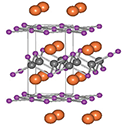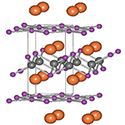Magnetism shortly before pairing
In an article published in Physical Review Letters, Hiroshi Mizoguchi and collaborators from the Tokyo Institute of Technology and the National Institute for Materials Science in Japan report the discovery of a new pnictide-type superconductor, , which exhibits a superconducting transition at around .
Structurally similar to the intensely studied pnictide superconductor , this material consists of alternating layers of bismuth and . The parent stoichiometric compound displays antiferromagnetic order, but not superconductivity. In these materials, interlayer interactions alter the effective mass of the mobile charge carriers that are present in each layer. In the case of , Mizoguchi et al. report that light electrons reside in the bismuth layers, while the layers host heavy electrons, with a remarkably large difference between the effective masses of both species. What is particularly interesting in this material is that the heavy electrons order at about to an antiferromagnetic state, while the light carriers pair to form a superconducting state at about . – Alex Klironomos





